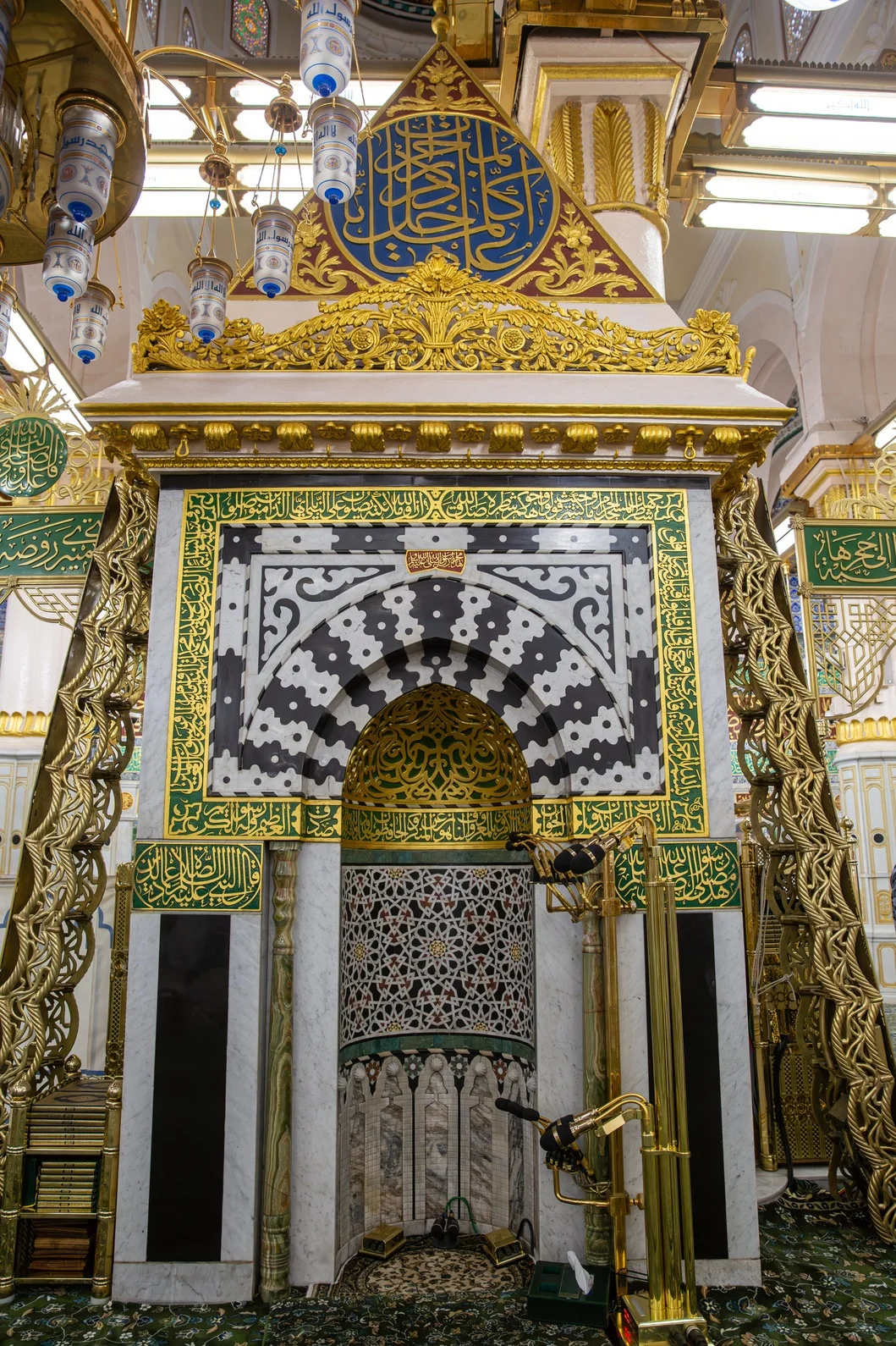
The Minbar of the Prophet
The Minbar in the Prophet’s Mosque is a prominent landmark with numerous virtues mentioned in hadiths. The Prophet Muhammad (peace and blessings be upon him) said, “What is between my house and my Minbar is a garden from the gardens of Paradise, and my Minbar is upon my river (al-Hawdh)” (narrated by Abu Huraira). It is also reported, “Whoever swears a false oath at my Minbar, let him take his seat in Hell, even if it is on a green miswak (tooth stick)” (narrated by Jabir, may Allah be pleased with him).
The Story of the Minbar
Initially, the Prophet (peace and blessings be upon him) leaned against a palm tree trunk during lengthy sermons. As narrated by Abu Buraydah from his father, the Prophet delivered sermons standing, which became difficult over time. A palm trunk was set up for him to lean on. A man from Medina, seeing this, offered to craft a Minbar for the Prophet to rest on. The Prophet agreed, and when he moved to the Minbar, the palm trunk cried out loudly. Jabir ibn Abdullah (may Allah be pleased with him) said, “The mosque was roofed with palm branches, and when the Prophet delivered sermons, he stood by one of them. When the Minbar was made, he stood on it, and we heard the palm trunk crying like a she-camel until the Prophet placed his hand on it, and it calmed down” (narrated by Bukhari).
Specifications of the Prophet's Minbar
Ibn Al-Najjar stated that the Prophet’s Minbar (peace and blessings be upon him) had a height of two cubits, a span, and three fingers, with a width of one cubit. The backrest height was one cubit, and the two knobs the Prophet held with his blessed hands when seated were a span and two fingers in length. According to the most reliable scholarly accounts, as noted by Al-Hafidh Ibn Hajar (may Allah have mercy upon him), the Minbar was crafted by Maymun, a carpenter in Medina.
Stages of Development of the Minbar Over History
-
During the Prophet’s Time and the Rightly Guided Caliphs: The Minbar consisted of two steps and a seat.
-
During the Umayyad Era: Marwan ibn al-Hakam added six steps during Muawiyah’s caliphate (may Allah be pleased with him), making it nine steps.
-
During the Abbasid Era: The Minbar was renewed due to its age.
-
In 656 AH: The Prophet’s Mosque and Minbar burned down, and King Al-Mudhaffar sent a new Minbar.
-
In 664 AH: Sultan Al-Zahir Baybars sent a new Minbar, which remained until 797 AH.
-
In 797 AH: Sultan Al-Zahir Barquq sent a new Minbar.
-
In 820 AH: Sultan Al-Muayyad Sheikh sent a new Minbar.
-
In 886 AH: The Prophet’s Mosque and Minbar burned down, and the people of Medina built a Minbar from bricks.
-
In 888 AH: Sultan Al-Ashraf Qaitbay sent a marble Minbar, replacing the previous one.
-
In 998 AH: Sultan Murad of the Ottoman Empire sent a beautifully decorated marble Minbar with twelve steps—three outside the door and nine inside—topped with a fine pyramid dome supported by four pillars. This is the Minbar currently in the Prophet’s Mosque.